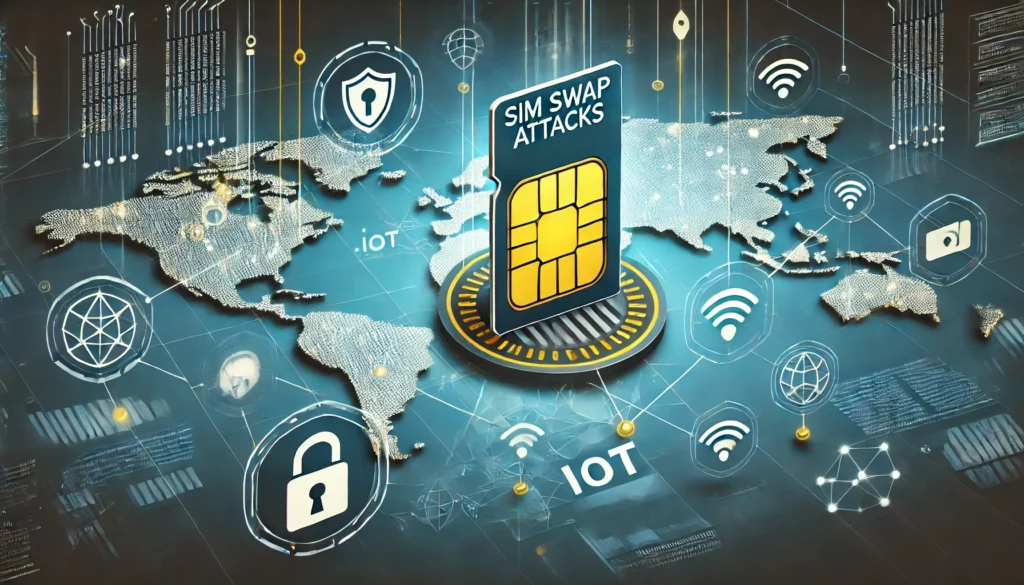In the digital age, SIM swap attacks have emerged as a sophisticated form of identity theft where cybercriminals deceive telecom providers into transferring a victim’s phone number to a new SIM card under their control. While these attacks are often associated with financial fraud and personal data breaches, they pose a significant threat to the Internet of Things (IoT) sector as well. Understanding SIM swap attacks in the IoT context is crucial for safeguarding the integrity and security of interconnected devices.
What is a SIM Swap Attack?
A SIM swap attack, also known as SIM hijacking, is a form of identity theft where attackers trick a mobile carrier into transferring a victim’s phone number to a SIM card they control. This enables the attacker to intercept calls, messages, and any other data sent to the victim’s number, allowing them to access accounts linked to that phone number.
How SIM Swap Attacks Work
SIM swap attacks typically involve a few key steps:

1. Information Gathering: Attackers gather personal information about the victim through phishing, social engineering, or data breaches. This information may include full names, addresses, phone numbers, and social security numbers.
2. Contacting the Carrier: Using the collected information, the attacker contacts the victim’s mobile carrier, impersonating the victim and requesting a SIM card swap. They may claim that the original SIM card was lost or damaged.
3. Verification and Swap: The carrier, often after insufficient verification, transfers the victim’s phone number to the new SIM card controlled by the attacker.
4. Accessing Accounts: With control of the phone number, the attacker can intercept two-factor authentication (2FA) codes and reset passwords for accounts linked to the number, including email, banking, and social media accounts.
Understanding how SIM swap attacks work is crucial for implementing effective security measures to protect IoT devices from such threats.
Risks of SIM Swap Attacks in IoT
SIM swap attacks pose significant risks to IoT devices, which rely on SIM cards for connectivity. The potential impacts include:

• Data Interception: Attackers can intercept sensitive data transmitted from IoT devices.
• Device Manipulation: Unauthorized control over IoT devices, leading to disruptions or malicious actions.
• Network Vulnerabilities: Compromised devices can be entry points for broader network attacks, exposing additional systems to risk.
Real-World Examples of IoT SIM Swap Attacks
Several incidents highlight the vulnerability of IoT devices to SIM swap attacks. For instance:
1. Smart Home Systems: Attackers gained control of smart home devices, disrupting services and accessing personal data.
2. Industrial IoT: In an industrial setting, compromised devices led to unauthorized access and manipulation of critical systems, resulting in operational disruptions.
3. Fleet Management: SIM swap attacks on vehicle tracking systems allowed unauthorized individuals to misdirect shipments and tamper with logistics data.
These examples underscore the importance of implementing robust security measures to protect IoT devices from SIM swap attacks.
How to Protect IoT Devices from SIM Swap Attacks

1. Strong Authentication Methods: Use multi-factor authentication (MFA) to add an extra layer of security. This can prevent unauthorized access even if the attacker controls the SIM card.
2. Device and Network Security: Implement robust encryption for data transmission and use secure communication protocols. Ensure that IoT devices have up-to-date firmware to protect against known vulnerabilities.
3. Carrier Collaboration: Work closely with mobile carriers to ensure that they have stringent verification processes in place for SIM card swaps and account changes. Collaborating with the right carrier is essential for implementing robust security protocols. Learn more about choosing the best carrier for your IoT needs in our guide on Choosing the Right Carrier Technology for IoT Devices.
Importance of Multi-Factor Authentication (MFA)
Multi-factor authentication is critical for securing IoT devices because it requires multiple forms of verification. Even if an attacker gains control of a SIM card, they would still need access to additional authentication factors, such as passwords or biometric verification. MFA significantly reduces the likelihood of successful SIM swap attacks.
Regular Monitoring and Alerts
Implementing continuous monitoring and setting up alerts for unusual activity can help detect and mitigate potential SIM swap attacks. This includes monitoring data usage patterns and device behavior to identify anomalies. Early detection through automated alerts allows for prompt responses, minimizing the impact of an attack.
Leveraging technology-agnostic solutions can enhance the security and flexibility of your IoT network. For insights into this approach, explore our article on the Advantages of Technology-Agnostic Internet IoT.
By adopting these strategies, businesses can significantly enhance the security of their IoT devices and networks, protecting them from the growing threat of SIM swap attacks.
As IoT networks transition from older technologies like 2G and 3G to more advanced options, it’s crucial to ensure that security measures are updated accordingly. For more information on this transition, check out our article on 2G and 3G Network Sunset: Preparing for the Future.
Conclusion
SIM swap attacks represent a significant threat to IoT devices, with potential impacts including data interception, device manipulation, and network vulnerabilities. Understanding how these attacks work and implementing robust security measures, such as multi-factor authentication, regular monitoring, and strong device and network security, is essential for protecting IoT deployments.
Proactive security measures are crucial in safeguarding against SIM swap attacks. To learn more about securing your IoT devices, explore Wagtel’s comprehensive IoT security solutions.
Contact us today to ensure your IoT network is protected from emerging threats.






